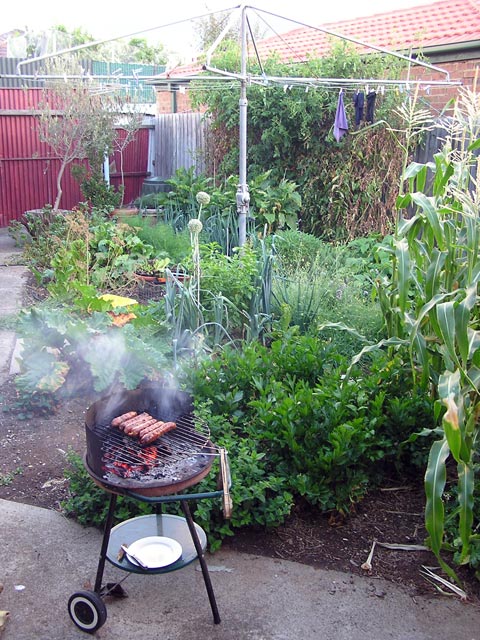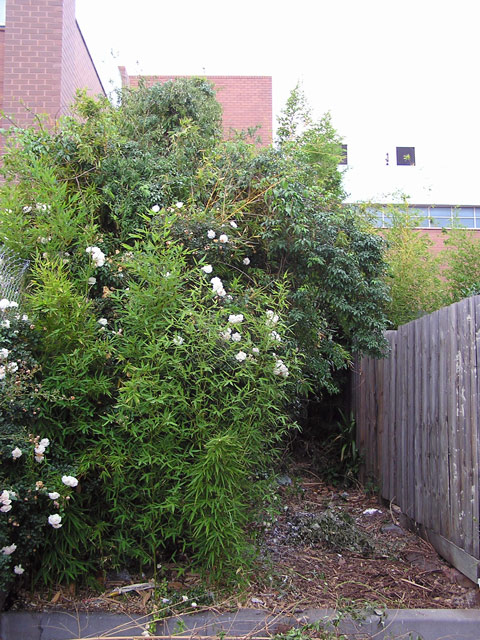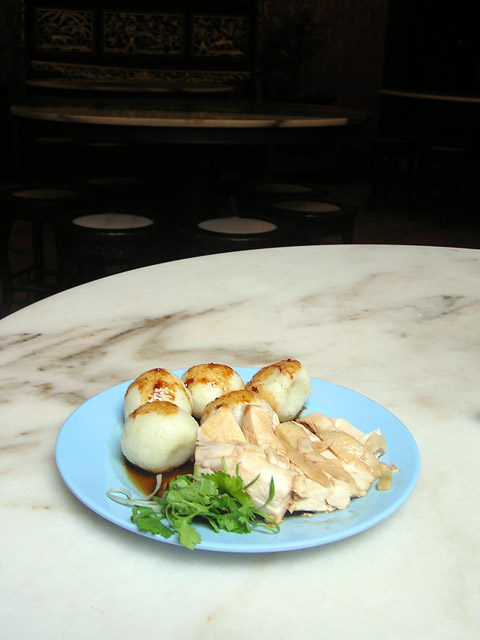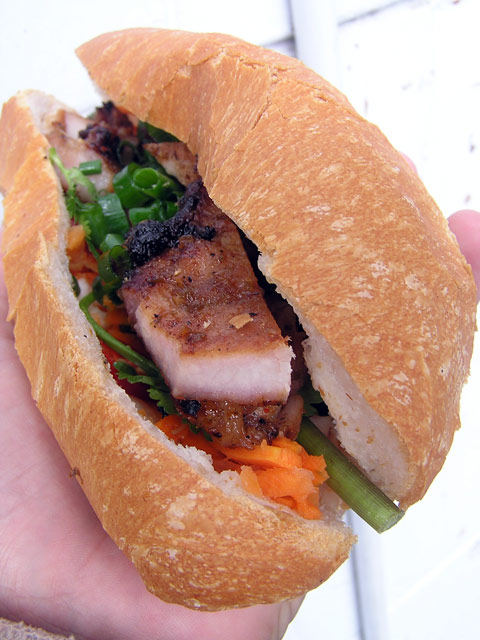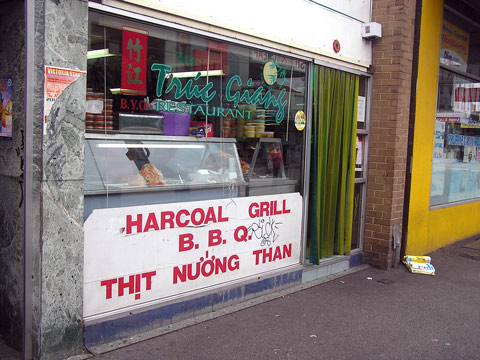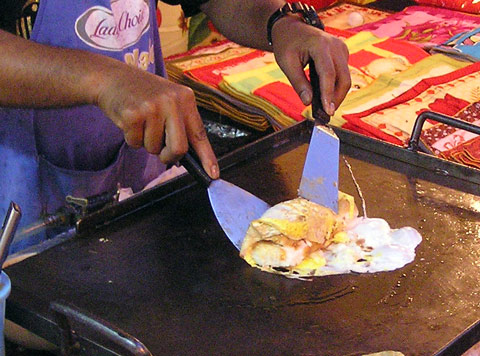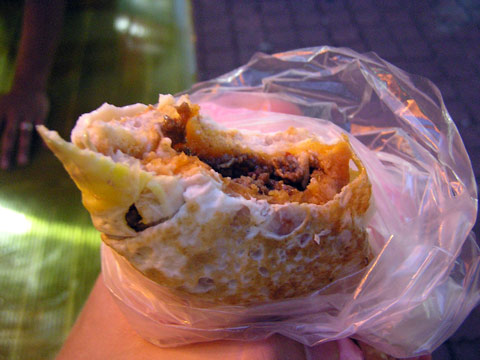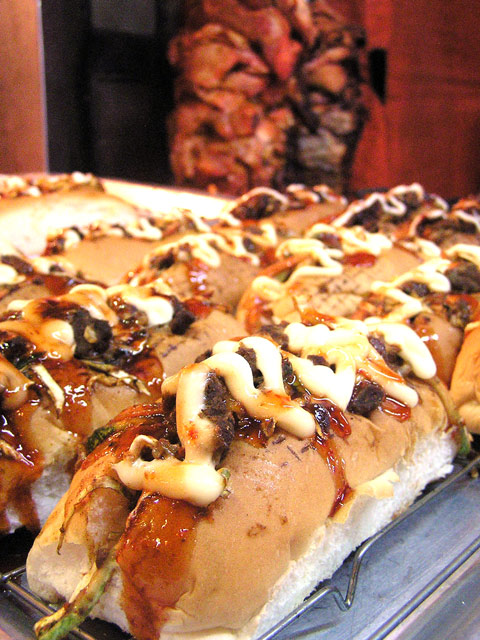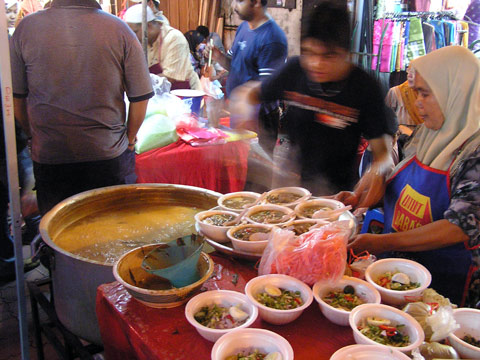- Michael Pollan summarises his “In Defence of Food” in 8 minutes (YouTube) – Who needs to read?
- Food Trends: Gelatin in your cocktail – Bacardi thinks that the future of mojitos is bubble tea. I’m personally looking forward to martinis in aspic.
- What is manufactured meat? (PDF) – According to Australian Standards Code, it is anything processed that is at least two-thirds meat. The other third can be anything edible.
- Where to eat in Bangkok – Austin Bush shows you where to go with Google Map mashup of his favourite haunts in downtown BKK
- Wine writers employed to write shower gel blurb – “notes of black licorice and glazed grapefruit in the woody-based blend of cedar wood, liquid amber and Tonka beans. The Smoothing Shower Scrub contains frozen tomato leaves combined with ginger candy and green melon notes”
Author Archives →
Sausage Fancier
Once you’ve seen how sausages are made, you’ll want to eat nothing but sausages. This was my first impression of home sausage making; my second was that making sausages is possibly my true calling and that my university loan debts could have been better spent on a meat mincer and practicing the barbecuing arts rather than on undergraduate degrees.
I started with a setup familiar to all new converts to the testaments of sausage making: a copy of Michael Ruhlman and Brian Polcyn’s Charcuterie and George Foreman’s Lean Mean Meat Mincing Machine. That George Foreman lends his moniker to an electric meat mincer is no great surprise to me. I discovered years ago that Foreman had made not less than nine billion American dollars from selling a multitude of appliances in no way limited to the indoor grill. The hypocrisy of adding the word “Lean” to a product that should be pumping out sausages that should be about 25% fat is not lost in me.
If you’re looking to lose weight, eating pork fat stuffed into a tube is not your best option. I’m sure that George would argue that his Lean Mean Meat Mincing Machine means that the home sausage fancier could control the fat content in their sausages just like he himself took control of his 1971 battle with Joe Frazier in Kingston, Jamaica, but I’d rather be eating richer, fattier sausages in moderation than the fat-free simulacra of a sausage. Fat is vital for human survival, just like the footwork Foreman displayed in his 1987 fight with Steve Zouski.
My first batch was perfect. I followed Ruhlman’s basic garlic sausage recipe and added a tablespoon of roughly crushed cumin seeds, chilli flakes, Kampot pepper, then lowered the salt content. The Lean Mean Meat Mincing Machine shudders away. I achieved the “primary bind” that Ruhlman mentions; once ground, the meat turns sticky as the protein breaks down. The casein skin burst only once while stuffing.
I grilled the sausages over charcoal as slowly as possible. I ate them with friends in absolute stunned silence.
I’ve begun eyeing off the greying cut-price meats in the supermarket refrigerators with a single question in mind: will it mince? What else can I stuff? What memories of sausages past can I recapture? How much of my life has been wasted not making my own sausages?
If there is one thing you can expect from this blog in the coming years, it is more sausage.
My basic garlic, cumin and pepper sausage recipe
(based on Michael Ruhlman and Brian Polcyn’s “Fresh Sausage Master Recipe: Fresh Garlic Sausage”)
Yields: about two and a half kilograms of sausages.
The original Ruhlman/Polcyn recipe calls for 3 tablespoons of salt. I ground in two tablespoons of this and fried up a patty of the mince to test the flavour before stuffing the casings. For me, it was salty enough but add more or less to your taste. Real intestine casings are tough to find in Australia. I went with casein.
Ingredients:
1 tablespoon of cumin seeds, coarsely ground
1 teaspoon of dried chilli flakes
1 tablespoon of Kampot pepper (or the best quality black pepper you can get), coarsely ground.
2 tablespoons of the cheapest salt available*.
3 tablespoons of minced garlic
2 cups of white wine
2.5 kilograms of fatty pork meat (approx 25% fat. I used 2 kilos of shoulder to 0.5 kilo of belly)
Method:
Pound the cumin, pepper and chilli flakes in a mortar and pestle until most of the cumin seeds are broken. Finely chop the garlic. Chop the meat into pieces small enough to fit into your mincer. Mix meat, spices and salt together in a bowl and refrigerate for at least two hours.
Soak casein casings in one cup of white wine.
Mince all ingredients into a bowl set in ice, on the fine (0.25cm) grade. Add one cup of wine and mix the mince until it becomes sticky. Fry up a patty of meat to test flavouring, then adjust anything to taste.
Change mincer to stuffer attachments. Thread about a metre of casings over attachment and tie the end in a knot. Pour mince into mincer and stuff away!
Section the giant sausage into odd lengths by twisting the casings – it is much easier to make one metre-long sausage and do this at the end of the process rather than juggling the sausage and the mincer. Charcuterie has a twee picture of measuring a sausage with a ruler as to ensure uniform size; my approach is less anal but equally obscene. Cook over a fire, as slowly as you can bear.
For a much more pictorial recipe, buy Ruhlman and Polcyn’s Charcuterie: The Craft of Salting, Smoking, and Curing.
* – Expensive salt makes no difference when dissolved in food, especially in sausages such as these which are packed with other aromatic components. Jeffrey Steingarten tests this out in It Must Have Been Something I Ate.
Just a small in-joke for my Khmer speaking homies
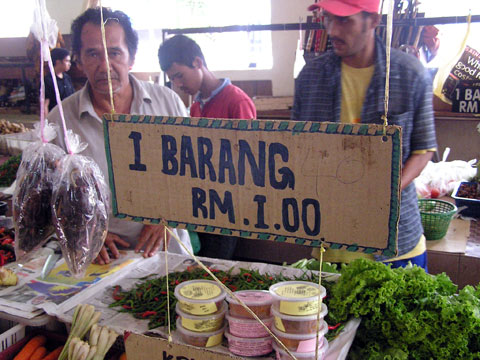
The falling price of the barang, Kota Bharu, Malaysia
Continue reading
The possibility of a guerrilla garden
In the modern city, horticulture is a transgressive sport. Modern urban developments tend to preclude growing fruit and vegetables as a possibility by offering only dark, windy balconies or paving over backyards, only conceding the mere edges to decorative, inedible shrubbery. The walls of suburban McMansions creep closer to the boundaries of their allotments offering scant room for plants.
After having spent the last month touring rental properties in Melbourne, the trend in renovating homes is to eradicate as much greenery as possible and replace it with pavers and a box hedge that looks indistinguishable from a plastic version of itself. The heartening trend towards adding grey water and rainwater tanks hasn’t filtered down to rental properties and most likely won’t while there is the trend for investors to buy houses and flip them onto the rental market as soon as Ikea drops in their cheap stainless-on-softwood kitchens.
These are spaces not meant to grow food.
Urban life in Australia (and much of the Western world) is designed to be separate from farming. There is the occasional community garden and the hardcore few who raze their lawns to plant vegetables anew (and add an obligatory chook shed) but these number amongst the minority. Subsisting in a city, while possible, is not preferable nor socially acceptable.
Behind my new apartment a typical Melburnian bluestone laneway has been curbed off by the local council, creating a semiprivate patch that is now overgrown. A bamboo plant battles for supremacy with an English climbing rose which offers a strange parallel to my eating habits. If I can weed out the overgrowth then there is a small chance to grow my own food and possibly some for the neighbours as well.
The real question is how much food?
And how soon?
Five Links on Friday: 22 February 2008
- Food Trend: Seaborne Chefs – Marco Pierre White hits the high seas, rented out by P&O Cruises
- Intestines in Coca Cola – Great Vietnamese offal recipe (in Vietnamese)
- Rachael at Thus Bakes Zarathustra wants to glass Jamie Oliver – and I want to watch.
- Food Trends: Malaysia’s Roti Boy and Papa Roti open in Korea – The forever expanding roti-verse engulfs South Korea
- The new grub street – How ethics became a food writing mainstay, at Columbia Journalism Review
Great balls of chicken rice
The apparent simplicity of Hainanese chicken rice is what makes it an addictive comfort food. It looks like simple steamed chicken and with fatty, chicken stock-cooked rice but is so fecund in people’s memories at it is impossible to begin to judge it. There are objectively bad plates of chicken rice replete with ropy strands of fowl; dry, stock-free rice and the umami-punch of MSG. What makes the perfect plate is harder to define. Certainly, moistness and tastiness of the bird plays a part, but can it be too moist? Some come served with a bonus small bowl of thin stock. Is this essential and should it be judged separately?
Each region puts its own twist on the recipe. The above plate is Melaka’s version, served with golf-ball shaped spheres of rice. Some places serve the chicken over rice, others present the components on separate plates. It is important to eat both some rice and some chicken in each mouthful, but when do you eat the thin bowl of stock that comes alongside the plate? I tend to eat it Cambodian-style, dipping a spoonful of rice into it, which in Malaysia, probably makes me look cretinous.
See also: Robyn and Dave at EatingAsia seek out the origins of chicken ball rice.
For chicken rice with balls: Hoe Kee, Jalan Hang Jebat (Jonker Walk), Melaka (Malacca), Malaysia.
“The only reason to move to Sydney would be to kick Bill Granger in his white-panted balls”
Which was how my friend J summarized my decision to move back to Melbourne. I personally have nothing against Bill Granger and he has nothing at all to do with my decision to not move anywhere near him. The other reason to move to Sydney seems that in my absence, the rental property market in Melbourne has gone to hell. The delicious dividend of the hellacious market is the following bánh mì thịt heo nướng, stumbled upon while I was between real estate agents in Footscray.
It is the real deal and unlike the properties that I saw, worth waiting in a queue to get. If I could live inside a sandwich, it would be this one. Flame-grilled chunks of marinated pork meat sit atop pickled, shredded carrot and daikon (instead of green papaya); coriander leaf and stalks; spring onions and fresh chili. The bun is as fresh as you’d find anywhere on the streets of Saigon, the meat even fresher.
The restaurant’s name, Truc Giang, betrays its Southern Vietnamese origins.
Price: $3
Location: Truc Giang Restaurant, 36a Leed St, Footscray, VIC
Phone: (03) 9689 9509
The last ditch

Saturday night market in Little India, Kuala Lumpur
If you could choose your last meal in a country, what would it be?
It’s a much more concrete question than some imagined last supper: unless you’re on death row or about to commit suicide then chances are you’ll have no power over the menu for your last meal, making it a question barely worth mooting as often as it is mooted. Most people who are executed don’t get any choice (contrary to the American myth) and being on your death bed also tends not to elevate the appetite. What the “last supper” question is really asking is “what is the best that you’ve already eaten?” from which the questioner is meant to discern the palate of the questioned or at least receive an answer pre-fried in nostalgia.
As for a last meal in Malaysia, what I’d do is bury myself neck-deep in a crowd and eat whatever the locals are chowing down upon, preferably in an open air environment.
Which is what I did.
The Saturday night market in Kuala Lumpur’s Little India could not be more packed without the crowd trampling each other to death ensuring that some in their midst had died whilst consuming their last meal. The food draws ecumenically from Malaysia’s street food faiths making it a great destination to either bone up on your knowledge of regional specialties or revisit the greatest hits of your time in Malaysia. There is also a great deal of street food that seems to be of questionable provenance, by far the most dangerous of meals.
Witness roti tarbus, a spicy Sloppy Joe made from a sweet white bun stuffed with minced, chilli-infused meat and wrapped entirely in a thin layer of fried egg.
Once again, Asia seems to be at the forefront of perfecting variations on American classics. The mix of chilli and fried egg is one of the world’s great flavour combinations in a one handed food.
Roti kebab is kebab meat fresh from the rotating pole, served up in a sweet bun topped with a squirt of commercial mayonnaise and a dose of barbecue sauce. Saccharine and squishy.
Fried chicken gets the stringy-looking outer coating from shreds of galangal, that lesser, woodier cousin of ginger; and is served in Styrofoam clamshells to be eaten elsewhere.
On the more traditional front, this stall is among the handful of street vendors outside of Penang to be serving Penang-style assam laksa, doling out both bowls and thin plastic bags. This version was tartly sour and thin but judging from the crowd and the near impossibility of procuring a seat on the communal tables behind the stall, this is the way that Kuala Lumpurites like it.
With a full stomach, I left Malaysia on the bus to Singapore, then onto Tiger Airways redeye to Melbourne, Australia via Darwin.
After almost three years, I’m home and it’s weird.
